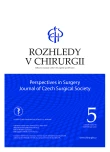Unexpected finding of an ablation catheter during thoracoscopic exploration for a spontaneous hemothorax – case report
Authors:
P. Juhos 1; M. Janík 1; M. Lučenič 1; K. Tarabová 2; D. Šiška 1; P. Lauček 1
Authors‘ workplace:
Klinika hrudníkovej chirurgie Slovenskej zdravotníckej univerzity a Univerzitná nemocnica Bratislava
1; Klinika anesteziológie a intenzívnej medicíny Lekárskej fakulty Univerzity Komenského a Univerzitná nemocnica Bratislava
2
Published in:
Rozhl. Chir., 2019, roč. 98, č. 5, s. 223-226.
Category:
Case Report
Overview
Varicose veins of lower extremities represent a common medical condition with minimally invasive percutaneous endovenous ablation techniques as a treatment of choice. A very rare complication is a catheter migration in the deep venous system. In the literature only 7 cases have been published so far, with only 2 cases with migration to the systemic circulation and heart involvement. In this paper we present an interesting case report from the perspective of a thoracic surgeon with the finding of a laser ablation catheter remnant in the left pleural cavity during thoracoscopic exploration for a spontaneous hemothorax in a 47-year old male patient after collapse. A similar complication affecting the pleural cavity has not been published before. In this paper we discuss possible routes of the cathether migration into the left pleural cavity, impending complications when a part of the catheter is left behind in the body and the means of prevention of these serious potentially fatal complications even after many years following the initial treatment.
Keywords:
varicose veins of lower extremities – endovenous laser ablation – complications – hemothorax – VATS
Sources
1. Evans CJ, Fowkes FG, Ruckley CV, et al. Prevalence of varicose veins and chronic venous insufficiency in men and women in the general population: Edinburgh Vein Study. J Epidemiol Community Health 1999;53:149–53.
2. Min RJ, Khilnani N, Zimmet SE. Endovenous laser treatment of saphenous vein reflux: long-term results. J Vasc Interv Radiol. 2003;14:991–6.
3. Ravi R, Rodriguez-Lopez JA, Trayler EA, et al. Endovenous ablation of incompetent saphenous veins: a large single-center experience. J Endovasc Ther. 2006;13:244–8. doi: 10.1583/05-1760R.1.
4. Agus GB, Mancini S, Magi, GIEWG. The first 1000 cases of Italian Endovenous-laser Working Group (IEWG). Rationale, and long-term outcomes for the 1999-2003 period. Int Angiol. 2006;25:209–15.
5. Meissner MH, Gloviczki P, Bergan J, et al. Primary chronic venous disorders. J Vasc Surg. 2007;46:54–67. doi: 10.1016/j.jvs.2007.08.038.
6. Nael R, Rathbun S. Treatment of varicose veins. Curr Treat Options Cardiovasc Med. 2009;11:91–103.
7. Rasmussen LH, Lawaetz M, Bjoern L, et al. Randomized clinical trial comparing endovenous laser ablation, radiofrequency ablation, foam sclerotherapy and surgical stripping for great saphenous varicose veins. Br J Surg. 2011;98:1079–87. doi: 10.1002/bjs.7555.
8. Nesbitt C, Eifell R, Coyne P, et al. Endovenous ablation (radiofrequency and laser) and foam sclerotherapy versus conventional surgery for great saphenous vein varices. Cochrane Database Syst Rev. (Online) 2011:1–66. doi: 10.1002/14651858.CD005624.
9. Ren S, Liu P, Wang W, Yang Y. Retained foreign body after laser ablation. Int Surg. 2012;97:293−5. doi: 10.3889/oamjms.2017.005.
10. van den Bos RR, Neumann M, de Roos K, et al. Endovenous laser ablation–induced complications: Review of the literature and new cases. Dermatologic surgery 2009;35:1206−14. doi: 10.1111/j.1524-4725.2009.01215.x.
11. Bozoglan O, Mese B, Inci MF, Eroglu E. A rare complication of endovenous laser ablation: intravascular laser catheter breakage. BMJ Case Rep. 2013; e-publ. doi:10.1136/bcr-2013-009012.
12. Holdstock JM, Marsh P, Whiteley MS, Price BA. It is possible to cause damage to a laser fibre during delivery of tumescent anaesthesia for endovenous laser ablation (EVLA). Eur J Vasc Endovasc Surg. 2008;36:473–6. doi:10.1016/j.ejvs.2008.06.011.
13. Manufacturer and user facility device experience (MAUDE) database. VNUS and EVLT 2008.
Labels
Surgery Orthopaedics Trauma surgeryArticle was published in
Perspectives in Surgery

2019 Issue 5
Most read in this issue
- Acute hiatal hernias
- An alternative method of surgical treatment in refractory GERD following laparoscopic sleeve gastrectomy
- Rare causes of acute appendicitis
- Early surgical management in patients with burns
